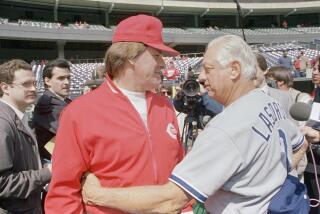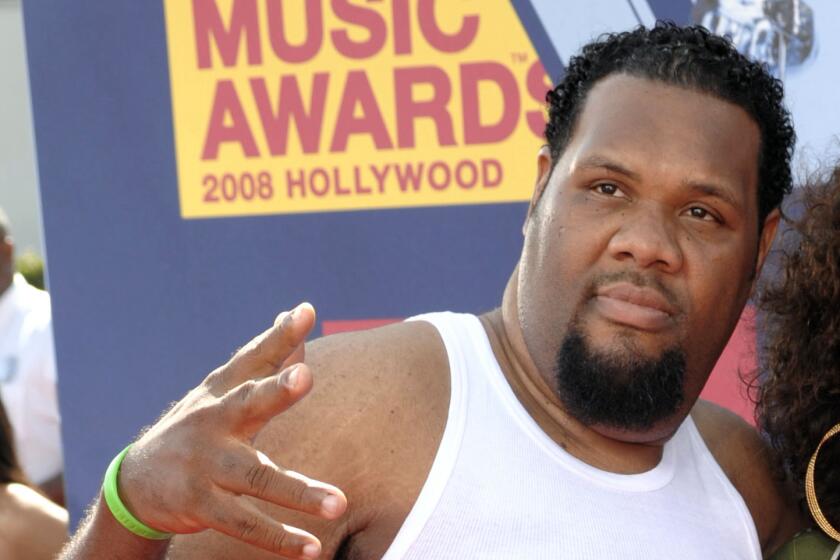POP MUSIC : This Could Be the Last Time : The Byrds are the only contenders for rockâs Hall of Fame who arenât facing a second--and perhaps final--chance to join the club
This is the year of the second chance for a lot of Rock and Roll Hall of Fame hopefuls. Or, in some cases, the year of the third, fourth, fifth or even sixth chance.
All but one of the 15 names on this yearâs Hall of Fame ballot were eligible previously. The list of holdovers includes such celebrated rock figures as Frankie Lymon, Wilson Pickett, Ike & Tina Turner, Gene Vincent and the Yardbirds.
Nearly 500 record industry leaders--mostly executives, musicians and critics--were asked to participate in this yearâs voting. The ballots are now being tabulated and an announcement on the new inductees is expected next month.
To be inducted, a nominee must be chosen by at least 50% of the voters. Up to seven artists will be inducted in the sixth annual Hall of Fame ceremonies Jan. 16 in New York City.
Why so many repeats this year?
The answer: a thin crop of pop arrivals in 1965.
Under Hall of Fame rules, performers become eligible 25 years after the release of their first record--in this yearâs case, 1965.
In the past, the annual balloting has been dominated by record-makers who were in their first year of Hall of Fame eligibility: the Beatles, the Beach Boys, Bob Dylan, Otis Redding, the Rolling Stones, Simon & Garfunkel, Stevie Wonder and the Who.
But this year, only one act that began its recording career in 1965 was considered strong enough to merit a place on the ballot: the Byrds, the classic Los Angeles rock band of the â60s and early â70s.
If that fact gives several early rock attractions another shot at the Hall of Fame, the downside is that this year may also be the last chance for most of them.
Anyone who is bypassed again is unlikely to earn enough support to be elected to the Hall of Fame in the future. Thatâs because the list of inductees over the next five years is again expected to be dominated by artists who will be in their first year of eligibility. They include the Band, the Buffalo Springfield, Cream, Creedence Clearwater Revival, the Doors, the Grateful Dead, the Jefferson Airplane, Janis Joplin, Led Zeppelin, Van Morrison, Sly & the Family Stone and the Velvet Underground.
Here is my rating of 12 of this yearâs 15 nominees--with artists listed alphabetically within categories. The remaining three nominees--John Lee Hooker, Elmore James and Jimmy Reed--deserve to be in the Hall of Fame, but as forefathers rather than performers.
The Musts
The Byrds-- Seven Top 40 singles--starting with a 1965 version of Bob Dylanâs âMr. Tambourine Manâ that was a landmark in the development of folk-rock. First year of eligibility.
By mixing folk and rock sensibilities in their early albums, the Byrds brought not only a new sound, but also a new sensibility to pop. The sound--with its distinctive, jingle-jangle guitar--continues to be one of rockâs richest and most appealing strains, reflected in the music of such contemporary groups as Tom Petty & the Heartbreakers and R.E.M. Equally important, the Byrds exhibited a sense of intelligence and artistic exploration that enabled the group to move productively from its early folk-rock all the way through its later country trimmings.
Johnny Cash-- Thirteen Top 40 singles, including âI Walk the Lineâ (1956) and âRing of Fireâ (1963), plus more than a dozen No. 1 singles in the country field. Eligible since 1985.
Cash was always more devoted to country music than rock, but he toured with Hall of Fame members Elvis Presley and Carl Perkins in the â50s and exhibited a deft hand at rockabilly. More importantly, his emphasis on songs with a social message and his string of concept albums in the early â60s demonstrated an artistic ambition and integrity that influenced artists ranging from Dylan to Springsteen. His induction would also help acknowledge the often-overlooked country music component in rock.
The Impressions-- Seventeen Top 40 singles, including âFor Your Precious Loveâ (1958) and âKeep on Pushingâ (1964). In addition, Curtis Mayfield had five Top 40 singles on his own, including âFreddieâs Deadâ (1972). Eligible since 1985.
Without the Motown promotional power and production wizards behind the group, the Impressions didnât enjoy the same commercial consistency of such rival R&B; acts as the Temptations and the Four Tops. Yet the Impressionsâ best records--many of them expressions of black pride and social consciousness--were among the most soulful and absorbing of the decade.
Ike and Tina Turner-- Six Top 40 singles as a team, including âProud Maryâ (1971), plus 16 R&B; hits . Eligible since the balloting began in 1985.
One of the mysteries of the Hall of Fame voting is why the Turners have been passed over time and again. Even if they had never made a record (and they made some marvelous ones, from the earthy drive of âA Fool in Loveâ to the spectacular sentimentality of the Phil Spector-produced âRiver Deep, Mountain Highâ), the duo would deserve a place in the Hall of Fame on the basis of their sizzling live shows.
The Yardbirds-- Six Top 40 hits--notably âFor Your Love,â âHeart Full of Soul,â âIâm a Manâ (1965). Eligible since 1989.
This British groupâs failure to win Hall of Fame approval last year--a year that saw such far less visionary outfits as the Four Seasons and Platters inducted--was another major puzzle. Some industry leaders may downgrade the â60s band because it broke up after only five years, but the groupâs accomplishments during that time were extroadinary. Yardbirds not only launched the careers of seminal guitarists Eric Clapton, Jeff Beck and Jimmy Page, but its guitar dynamics also pointed a direction for countless musicians who followed.
Next in Line
Frankie Lymon-- Stats: Three pop hits--including âWhy Do Fools Fall in Loveâ (1956) and âGoody, Goodyâ (1957)--plus six R&B; hits. Eligible since 1985.
Lymon was barely into his teens when the Teenagers went into the studio to record âWhy Do Fools Fall in Love,â a record that is perhaps rivaled only by the Jackson 5âs âI Want You Backâ in terms of pure youthful verve. Lymonâs life and career were cut short by various personal problems (he died of a drug overdose in 1968), but no other teen singer has ever quite matched his vocal command.
Wilson Pickett-- Stats: Sixteen Top 40 hits, including âIn the Midnight Hourâ (1965). Eligible since 1988.
Pickett has never been a subtle singer and he was indebted on his hits to the power of the arrangements and the backing bands, but his brash, sexy attitude on stage and on record defined the aggressive, impassioned image of a male soul singer in the â60s as much as anyone other than James Brown.
Longshots
LaVern Baker-- Stats: Seven Top 40 singles, including âTweedlee Deeâ (1955), plus 20 Top 40 R&B; hits. Eligible since 1985.
Along with Atlantic Records label-mate Ruth Brown, Baker was one of the first female stars in rock and she was equally effective on novelties and ballads, but her ultimate impact was limited.
Bobby (Blue) Bland-- Stats: Four Top 40 singles, including âTurn on Your Love Lightâ (1961) and 50 R&B; hits. Eligible since 1985.
A classy and controlled blues singer whose style has been an influence on a generation of singers, including Van Morrison. Still, Blandâs ties to rock have been slim. Look to the Blues Hall of Fame instead.
Duane Eddy-- Stats: Fifteen instrumental hits, including âRebel-Rouserâ (1958) and âPeter Gunnâ (1960). Eligible since 1985.
No doubt about the influence of Eddyâs twangy, rumbling guitar style and technological advances, but the sound was often wasted on mediocre material.
The Moonglows-- Stats: Three pop hits--notably âSincerelyâ (1955)--plus seven Top 40 R&B; hits, including âTen Commandments of Loveâ (1958). Eligible since 1985.
An outstanding vocal group, but its contribution to the history of rock seems to warrant a prominent place in a Hall of Fame display saluting the doo-wop tradition rather than a full-fledged Hall of Fame induction.
Gene Vincent-- Stats: Three Top 40 hits, most significantly âBe-Bop-A-Lulaâ (1956). Eligible since 1985.
Vincent made one great record (the sensual, Presley-influenced âBe-Bop-A-Lulaâ) and a few more very good ones, but theyâre not enough to earn him a place in the Hall of Fame alongside Little Richard and the Beatles.
More to Read
The biggest entertainment stories
Get our big stories about Hollywood, film, television, music, arts, culture and more right in your inbox as soon as they publish.
You may occasionally receive promotional content from the Los Angeles Times.










